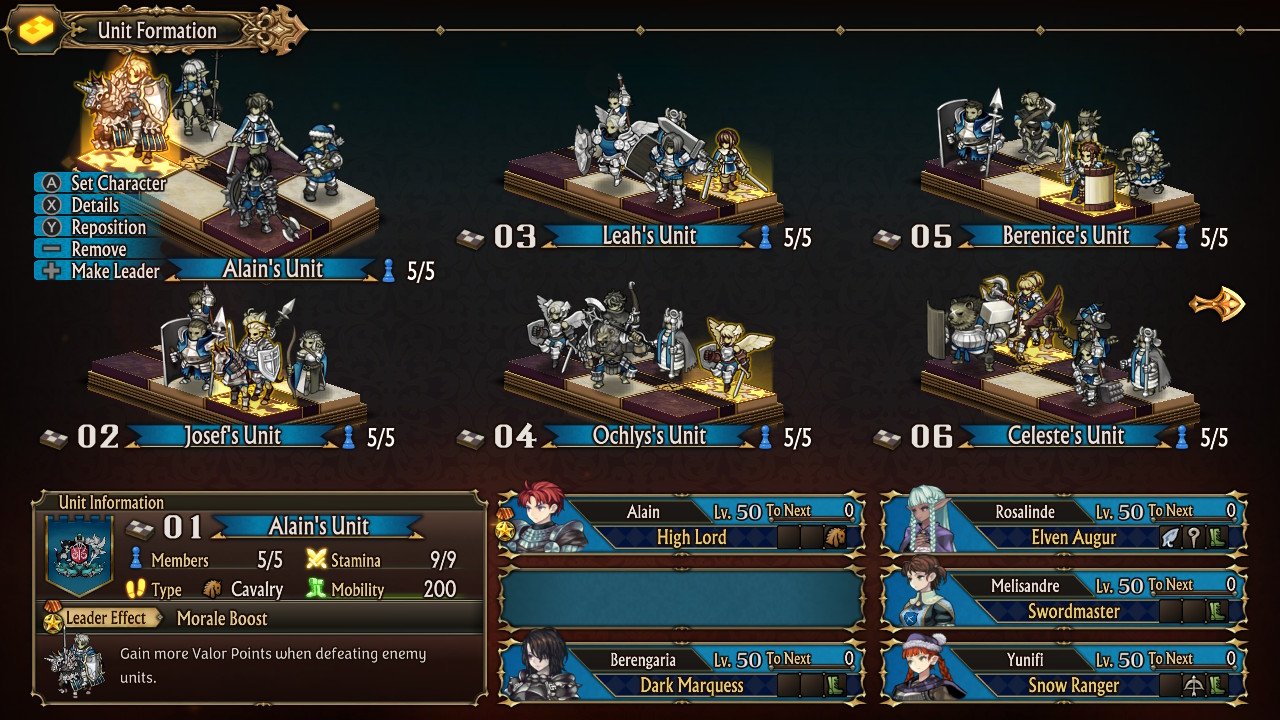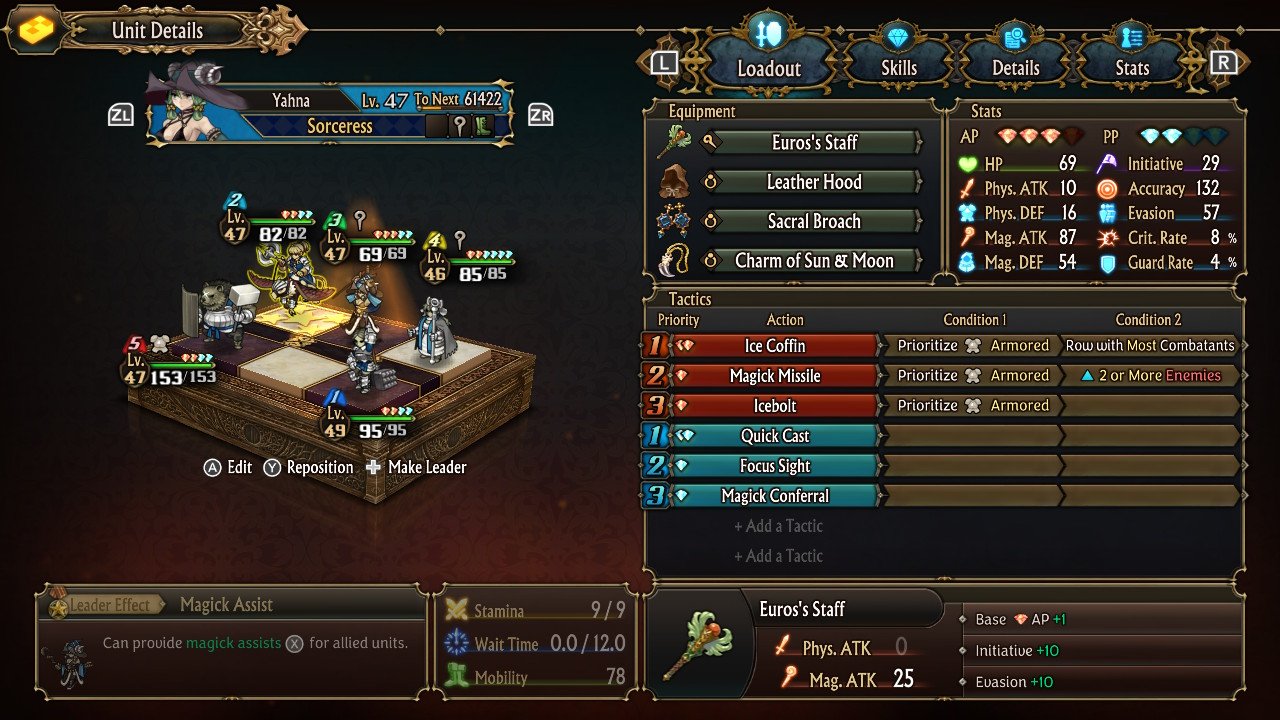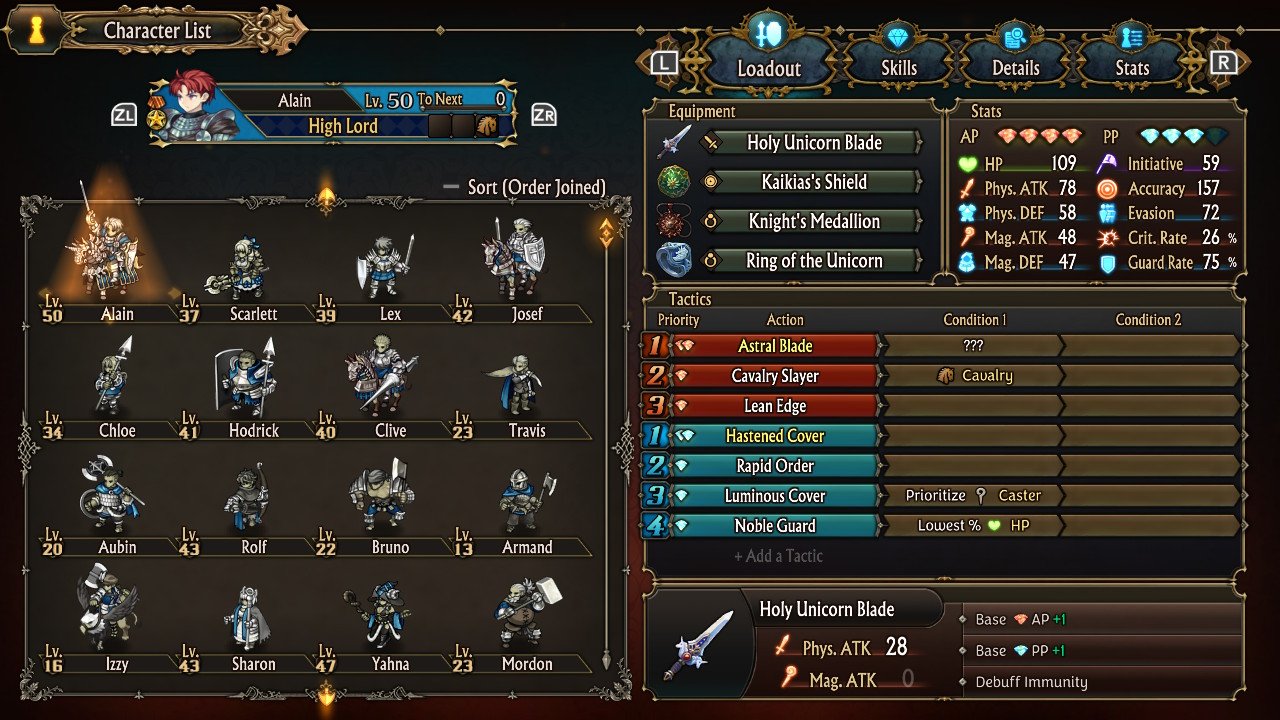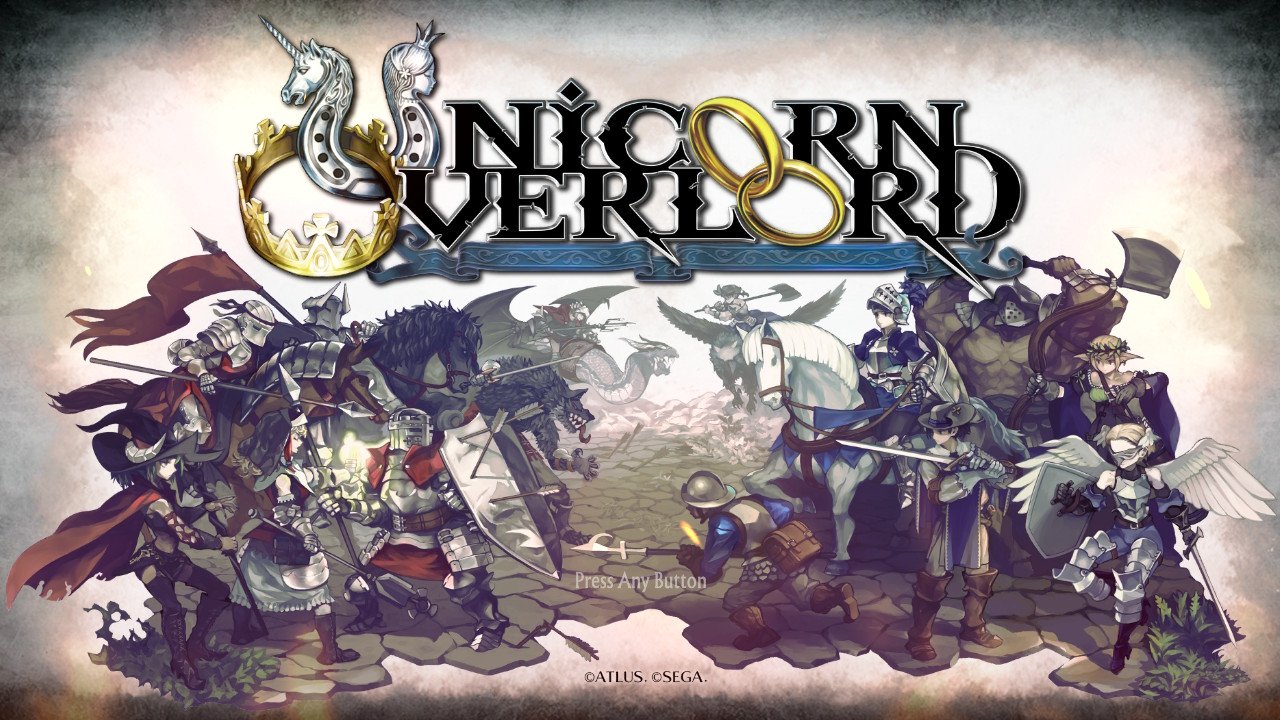Unicorn Overlord Review
The bones of Fire Emblem With the heart of SuikodenWARNING: THIS ARTICLE MAY CONTAIN DISCUSSIONS involving SPOILERS FROM THe Unicorn Overlord game. CONSIDER WHEN AND WHERE IT WOULD BE APPROPRIATE TO READ THIS PIECE.
WE ARE A PARTICIPANT IN THE AMAZON SERVICES LLC ASSOCIATES PROGRAM, AN AFFILIATE ADVERTISING PROGRAM DESIGNED TO PROVIDE A MEANS FOR US TO EARN FEES AND SUPPORT OUR CHANNEL BY LINKING TO AMAZON.COM AND AFFILIATED SITES.Nakama Gathering Genre Is Back!
Platforms
We Reviewed our copy of Unicorn Overlord on the Nintendo SwitchIt is currently also available on Playstation 4, Playstation 5, Xbox Series X, and Xbox Series S
As an avid RPG fan for more than 30 years now, I’ve been fortunate enough to have been born at the opportune time in history to experience some of the greatest role playing video games from nearly the very beginning of the genre. Whenever I have a discussion with someone about the best RPG games ever made, I somehow always end up talking about Konami’s 1998 title, Suikoden II. The Suikoden franchise left a profound mark on me and it has been far too long since its departure from the gaming world. I’ve found that modern Fire Emblem games fill some of that void left in this niche nakama gathering genre, but I really haven’t played a game that made me feel whatever it is that Suikoden II made me feel since Suikoden Tierkreis on the Nintendo DS more than a decade ago.
While media headlines across the world will compare Vanillaware’s new Unicorn Overlord game to Fire Emblem (which is true), I genuinely felt reminiscent of my adventure gathering the 108 Stars of Destiny in Suikoden II while liberating the lands of Cornia. Unicorn Overlord is a fantastic game that refines and revitalizes multiple longstanding RPG stances, and after more than 55 hours completing the game, I’m confident in saying that it is one of the most enjoyable RPGs to come out in recent years. The nakama gathering genre is back baby!
From a technical perspective, Unicorn Overlord is classified as a tactical RPG where the player doesn’t actually control the characters during battle. Like Fire Emblem and Ogre Battle, your job is to build teams of characters with their unique traits and to station them on a map to defeat the enemy. The battles themselves are automatically played out and whichever unit has the higher combined total number wins. This is very much so a military strategy game that will test a player’s ability to critically think about exit strategies and when to push and pull.
You can recruit up to 70 original characters to join your army
The Liberation Army
In terms of story, Vanillaware didn’t reinvent the “exiled prince starts a rebellion to reclaim the throne” plot. We get to play an exiled prince named Alain, as he travels across the world of Cornia, liberating one town after another from the brutal Zenoiran Empire’s tyranny. It’s actually as basic as it can get in terms of storytelling, but that isn’t necessarily bad. There’s something absolutely fascinating being able to travel on foot around different nations, gathering allies, all the while growing stronger to one day head back to acquire your birthright. It’s like we get to experience what it’s like to be Daenarys or Jon Snow from Game of Thrones. Who wouldn’t enjoy that right?
Where Unicorn Overlord falls into a bit of a rut is through the over reliance on turning enemies into friends. There’s nothing wrong with an enemy to friend trope every once in a while, but I’d probably estimate that about one-third of the heroes we get to add to our ever growing roster of liberationists used to fight for the bad guys. In fact, when “joins if you decided not to execute them” is a prerequisite for acquiring more than 7 or so new characters, it becomes a recurring theme. There are 69 recruitable original characters, and 70 overall when you account for Alain. This doesn’t include the editable generated mercenaries that can be hired to join your team. That’s a good sized roster and many of the characters are surprisingly memorable with their background stories. They grow on you over time and before you know it, you come to care about not just them as individuals, but their kinship with one another inside the confines of your liberation army.
Why do we get so invested in the lives of video game characters?
This is something that Suikoden mastered and changed the way players viewed secondary characters in video games. In most stories, players only really care about the main cast of characters as they traverse and bond on-screen. While there still is technically a “main cast” of sorts that progress the main story plot, I didn’t feel like any recruitable character was necessarily left behind or didn’t feel important. Vanillaware has done an excellent job of building a world within a world that feels absolutely simple and endearing to get into as a player. It’s also very realistic to recruit every single character in just one playthrough, something that isn’t that easy to do in past Suikoden games. The recruitable characters here are linear in the way they are acquired. I ultimately missed out on only two characters that ironically had their fates tied together.
Netflix’s Avatar The Last Airbender Review
THE NETFLIX ADAPTATION LOSES THEIR WAY, BUT EVENTUALLY FINDS ITS SPIRITWaifu Collecting Done Right
Relationships with the troops are pivotal to the story of Unicorn Overlord, so much so that the main plot is actually dictated by who you have Alain choose as their partner at the end of Act Three. The Unicorn and Maiden rings are representations of a power forged by a true bond that has the capabilities to purify the evil spread from the dictator Galerius and his minions. Those rings are what Alain and his cast of liberators chase around the world to strengthen before the final battle.
Like the marriage systems through Fire Emblem’s lineup, Unicorn Overlord encourages players to spend time building rapport between Alain and his nakama. By sharing a meal at a tavern, or gifting gifts to stationed characters in a city or town, hearts can be built up between characters. When a rapport reaches a new heart level, it will often trigger a conversation scene somewhere on the map between the two characters. Not all characters have scenes with one another. You can see which ones do by the markings inside the heart icons. Once three hearts are built up and any available scenes have been watched, Alain will be forced to make an important decision in who he will take as a partner.
Alain can propose to nearly every one of his nakama
Yes, waifu collecting is fun in games like this, yet often hated by certain gamers, but it actually has a purpose to the plot in this particular game. Alain has to find a partner who he trusts and has a strong bond emotionally with in order to save his home and the world. In many cases with the female characters, this is a romantic bond that will lead them to becoming Alain’s bride and future Queen of Cornia. Some of the relationships feel platonic and I actually appreciated the broadness in which you as a player can interpret the dialogue between Alain and those characters. There’s definitely a handful of Maidens that you can definitely tell are designed to be serious suitors for Alain as they are much more flirty and direct with their intentions. However, there are also some characters that build subtle kinship with Alain that I grew to adore the budding chemistry that I wouldn’t have expected to occur.
The abrasive plague nurse, Tatiana, and the former enemy general, Berengaria, are two great examples of unlikely romance candidates that won me over at the end. In fact, Berengaria’s proposal scene is one of the most uniquely written and physically interacted scene options out of all of the Maiden candidates. I know I was taking this too seriously when it took me nearly an hour to decide who I wanted Alain to end up with at the end of my first playthrough. I picked the perky, yet fiercely loyal priestess elf, Rosalinde, if anyone was wondering.
I also appreciated how Vanillaware has emboldened players to choose between every single recruitable unique character as a Maiden. That includes all genders and races. Literally every single recruitable character before the final battle that has a speaking voice can be Alain’s partner in the end. We’re talking about male and female angels, furry owls, bears, foxes, wolves, lions, and elves. You can even choose old men and your biologically related cousin to be the one standing with you at the very end. I applaud the developers for giving such a diverse set of choices as I’m sure each character has left an impression on at least one person playing.
Yes, Rosalinde is the best Queen Consort
I did find the male proposal scenes to not push the romance boundaries as far as the female options did. In many scenes, it seems like Alain is merely brushing around the technicalities of the Ring of Maiden’s rules to bestow it onto a best friend that he trusts, instead of it being a truly gay romantic option. There are “minor blink and you miss it” implications in bits of dialogue that may or may not imply romance, but it would have been nice if they fully committed to a romantic direction with more male characters. I haven’t cycled through every single ritual scene yet, but that was my takeaway after watching a majority of them.
The fun thing about Unicorn Overlord is that the rapport system can be done with members of the army between themselves. That means we get to see interactions and relationships between other characters and factions within the ranks of the army, and outside of their talks with the Prince. This just makes each character feel that much more real and important as they have their own lives and backstories to explore that don’t have to do with Alain. They have unique personalities that mesh well with some of their teammates, but may not blend well with others. It’s a standout feature in games like this and one of the reasons I am so drawn to what I call the Suikoden style of play. The method in which we acquire rapport is rather shallow in Unicorn Overlord, and the rapport dialogue scenes aren’t as sophisticated as even 3DS-era Fire Emblem games, but at the end of the day, it’s the moments in the scenes that matter to our experiences.
Beautiful 2D World
The overworld is fun to move across
Speaking of our experiences, Unicorn Overlord is absolutely stunning to look at. All the characters and locations are compiled from 2D art. There’s depth in the environments that you travel around in, but it universally feels and looks like a modernized platform of older overworld RPGs. 2D mini-sprites are used for overworld and battle maps, while the cut scenes and battle scenes have full character art. They just flow well transitioning between one another.
Battle encounters are displayed on a flat plane with enemies on the left, and our characters on the right. It’s exactly like Fire Emblem. However, unlike the newer Fire Emblem titles that have transitioned over to 3D models, there’s a unified playing experience built into the world of Cornia. There are no grids on the map like lots of tactical RPGs. You point and select where each unit goes on the quest map.
The battles are quick paced and don’t feel that detached from the details of the battle map. Actually, the battle map itself does not feel detached from the overworld map either. I loved how seamless the gameplay felt throughout every game system Unicorn Overlord introduces to us players. Overworld maps used to have such an annoying reputation for RPG fans. I can’t put into words how visibly frustrated I was taking one or two steps in Final Fantasy overworld maps prior to Final Fantasy XII. The transitions from the map to the battle interfaces were so jarring and would become a nuisance after the 20th encounter in less than 5 minutes.
Vanillaware has nearly perfected what I personally want to see from an overworld map. Not only are the environments beautifully developed, but it’s so easy to run through one town to another. It genuinely feels as if Alain is on the ground of this world running through a swamp into a town, or moving between a desert from one coast to another. Exploring the multiple continents in the world doesn't feel like a daunting task. It’s actually fun. Even though it’s technically a chore to collect glowing materials off the floor to help rebuild war-torn towns, I found myself enjoying revisiting areas I’ve passed by, just to see if I missed anything previously.
The art and character movements are beautifully crafted
Playing Your Game
The game doesn’t hold your hand and force you to do what it wants either. For the most part, you can explore whatever continent you want to reach in whatever order you want, as long as you have the proper resources required to get there. There are power level roadblocks, but they aren’t as littered across the map as you may expect. You can actually beat the final boss in Act One if you really wanted to, although the story will end extremely differently if you do decide to do that. I must have glossed over the minimal tutorial pop up tips, because I didn’t know there was a fast travel system until about 20 hours into my game. I also didn’t know you could customize your heroes by changing their appearances and outfit colors using an item until near the end of my quest. I actually enjoyed experiencing all that Unicorn Overlord has to offer on my own fruition and time.
you don’t feel like you're pausing your gameplay to watch a movie like most modern games with their 10 minute cut scenes.
For my playthrough, I really started running out of things to explore around the 53rd hour of play. When you’re wrapping up loose ends on those side quests and treasure maps, it’s a sad feeling, knowing that you’ve found everything there is to find in the game. Don’t get me wrong, there’s quite a lot to discover, but the exploration to find those things feel natural in the progression of the main quest the liberation goes through. As Act Three nears its conclusion, I surmise most players will be in a similar position as where I was in the game with materials and weapon collection.
The way Vanillaware lets you experience the adventure is also worthy of praise. Like the transitions from overworld map into a battle, the cut scenes are integrated in a highly unobtrusive manner. They completely match the tone of the rest of the game and you don’t feel like you're pausing your gameplay to watch a movie like most modern games with their 10 minute cut scenes. You can skip just about every single scene without needing to watch through it once. Scenes are also the right length to provide you the information needed to progress the story, but not overbearing in dialogue or exposition.
Simple Tactics…Maybe Not



For a tactical game, Unicorn Overlord really isn’t that overly complex. You are able to comprise up to 10 parties of 5 characters each that go into battle. Each team gets assigned a leader and that leader’s special effect will be available to that unit. The leader will also be the representative of that team as they move on the battle map. A character who rides on a gryphon like the knight, Fran, will be able to carry their team across bodies of water and over mountains.
All of the characters fall into a typecast, or what RPGs call classes. Once again, Unicorn Overlord doesn’t reinvent the wheel here as the classes in this world are as basic as it gets for this medieval setting. You have your clerics that heal, your archers that specialize in AOE attacks, calvary units that can get from one spot to another on the map the quickest, magic casting units, flying units, and tanks who specialize in absorbing damage. In this adventure, there’s only one class upgrade for the heroes you’ve gathered in the first half of the game to level up. Most of the later heroes who join the cast are already in their final advanced classes. There’s no decision making process required as each character’s class is locked in their path line and there are no diverging options to choose from.
Each team also has a certain amount of battles they can partake in every mission before depleting their stamina. There are methods to refill the stamina points like resting, but if an enemy attacks that unit while they’re recuperating, they will be left vulnerable and take heavy damage. This is where the tactics aspect comes in. A savy military commander will split their troops up and deploy them at the proper strategic moment.
Knowing when to attack and retreat is vital
The weakness chart is a bit more complicated than that of Fire Emblem’s, but for the most part, logical scenarios still ring true as archers do more damage against flying units, while those said flying units destroy cavalry ones. Those horse riders tramp over regular infantry classes. While that’s the general guideline of the battle hierarchy, Unicorn Overlord actually does a relatively good job of dispelling this in later portions of the game through how you build your specific class up. Weapons and armor contain certain special abilities that can change how a class handles their opponents.
On that note, you can configure the specifications of when and how a character uses their two types of skill sets, Active Points (AP) and Passive Points (PP). For example, the priestess, Scarlett, can quick heal her teammates after they take damage, but you may not want her to waste a heal on a character who has sustained minimal wounds. By setting one of her two conditions for casting that spell with a requirement of healing “only when health is at 50%” she will not act with that skill on minor scrapes. You can get quite specific in how you manage and build teams.
Unicorn Overlord also packs skills that can be used on the battle map that are called Valor Skills. Each character has a specific skill set they can gain and utilize on the map. Some do damage to opponents on the map without needing to go into battle, thus weakening the opponent and giving your units an edge entering battle. Others can heal or buff nearby teammate units. When you factor these Valor Skills into your team construction, there are some absolutely fun combinations you can pull off as an ace in the hole. I personally loved saving my best unit to deploy towards the middle or end of a quest, and instantly teleporting that fresh unit to the end location where my winded units who have been on the map for a long time have grinded us forward to. The royal court witch, Yahna’s Valor Skill, is teleport. When her unit lands near a mob of enemies thanks to that skill, it’s so fun to hit them with a surprise AOE attack from a character like the crusader, Virginia, who’s Valor Skill hits all enemies within her range.
A Future Cult Classic
I’ve really only touched the surface when talking about Unicorn Overlord. The voice acting was terrific. The character designs are neither too bland nor offer too much fan service. Most if not all of the characters wear some sort of armor or breastplate to cover their bodies like you would expect a soldier to wear to battle for a setting like this. The only outliers are the beastmen and sorcerer classes, but those are fantasy-based, and even then, I didn’t find their outfits to be too exotic. What I’m getting at is that Vanillaware has made characters with designs for anyone. There are characters that should satisfy the more anime-loving fanbase, but also cover the conservative field that don’t want to see a game full of bikini armor.
Reminiscing about the great memories
While we’re only about a month out from Suikoden’s true spiritual successor, Eiyuden Chronicle: Hundred Heroes, I can honestly say that Unicorn Overlord has carved a special place in my gaming library. I thoroughly enjoyed my time fighting through Cornia, and the hours just flew by. I surmise this will be a title that will end up as a cult classic that we’ll look back at fondly. There’s not a whole lot of replay ability after completing the main quest, with only one additional side-quest added to your log after saving the world. The coliseum mode allows for PVP online, but even that doesn’t satiate the void left on this character-driven game upon it’s completion.
Unicorn Overlord isn’t perfect, but it’s surprisingly refined and sneakily charming. I had post-game sadness after completing the final quest and watching the epilogue showcasing the endings of all the characters I gathered during my time in Cornia. It’s the same feeling I had after completing Suikoden II all those years ago. You feel like you’re departing from a group of friends that you’ve grown attached to and fought alongside with. These feelings are heightened so much more when the cast is of a larger scale like this. JRPGs have always had a reputation for grand tales of adventure. My lasting thoughts about Unicorn Overlord is that it’s a game that perfectly illustrates how letting players just play the game by treating them as part of the journey instead of as an absent minded viewer, will make the adventure all the more enjoyable. A generic story doesn’t feel as generic when you’re there in the trenches leading the charge instead of watching it unfold.





Alex
Caught in between the conundrum of his fascination with retro and the future, Alex has a very unique taste in technology. Never one to follow trends like his millennial peers yet constantly desiring to get ahead of the curve, he sees technology like he does his other love: comic books. Always looking for the best value or a hidden gem, his collector mindset reflects on some of his favorite gadgets: the Moto X (2015), HTC U11 and the Google Pixelbook. If there’s a good tech deal out there, Alex is on the hunt!